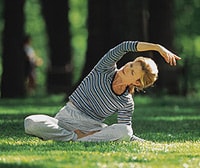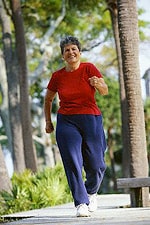Contrary to popular belief, we as a race have not become greedier or less active in recent years. But one thing that has changed is the food we eat, and, more specifically, the sheer amount of sugar we ingest.
"Genetically, human beings haven't changed, but our environment, our access to cheap food has," says Professor Jimmy Bell, obesity specialist at Imperial College, London.
"We're being bombarded every day by the food industry to consume more and more food.
"It's a war between our bodies and the demands our body makes, and the accessibility that modern society gives us with food. And as a scientist I feel really depressed, because we are losing the war against obesity."
One of the biggest changes in our modern diet stems back to the 1970s when US agriculture embarked on the mass-production of corn and of high-fructose corn syrup, commonly used as a sweetener in processed foods.
This led to a massive surge in the quantities of cheaper food being supplied to American supermarkets, everything from cheap cereal to cheap biscuits. As a result, burgers got bigger and fries (fried in corn oil) got fattier.
According to nutritionist Marion Nestle, this paved the way for obesity.
Continue reading the main story
“Start Quote
Obesity is caused when people consume too many calories without the exercise to balance it out”
Susan NeelyAmerican Beverage Association
"The number of calories produced in America, and available to American consumers, went from 3,200 in the 1970s and early 80s to 3,900 per person, almost twice as much as anybody needed. And that enormous increase, I think it's the cause of a great deal of difficulty," she says.
High Fructose Corn Syrup (HFCS), a highly sweet by-product of waste corn, was also incredibly cheap. It began being used in every conceivable food - pizzas, coleslaw, meat. It provided a "just baked" sheen on bread and cakes.
By the mid 1980s, corn syrup had replaced sugar in fizzy soft drinks. The move made financial sense from the soft drink companies' point of view, as corn syrup was a third cheaper than sugar.
But it was also sweeter and, argue some scientists, more addictive. In the next two decades, the average American's consumption of fizzy drinks almost doubled - from 350 cans a year to 600.
But Susan Neely from the American Beverage Association says the increased consumption of fizzy drinks is not to blame for increased obesity in the West.
"The evidence says that obesity is caused when people consume too many calories without the exercise to balance it out," she says.
"Certainly our regular soft drinks are a source of calories, so if you're consuming too many calories and watching too much television or not getting enough exercise, you're going to have a problem."
Weight gain
Dr Jean-Marc Schwarz from San Francisco General Hospital says it's the sheer amount of fructose being consumed that makes it dangerous.
"It doesn't have a toxic effect like lead. It's not comparable to lead or mercury, but it's the quantity that just makes it toxic," he says.
Fructose is easily converted to fat in the body, and scientists have found that it also suppresses the action of a vital hormone called leptin.
"Leptin goes from your fat cells to your brain and tells your brain you've had enough, you don't need to eat that second piece of cheesecake," says Dr Robert Lustig, an endocrinologist.
He says when the liver is overloaded with sugars, leptin simply stops working, and as a result the body doesn't know when it's full.
"It makes your brain think you're starving and now what you have is a vicious cycle of consumption, disease and addiction. Which explains what has happened the world over," he says.
Heart disease
In the mid-1970s, a fierce debate raged behind the closed doors of academia over heart disease. It boiled down to one simple question: what causes it - sugar or fat?
The view that fat was to blame prevailed, and in doing so it created an entirely new genre of food - "low-fat" products.
The creation of "low fat" promised an immense business opportunity forged from the potential disaster of heart disease.
Continue reading the main story
“Start Quote
When you're eating food that is highly hedonic, it sort of takes over your brain”
David KesslerFormer head, US Food and Drug Administration
Overnight, low-fat products arrived on the shelves. Low-fat yoghurts, spreads, desserts and biscuits. All with the fat taken out, and largely replaced with sugar.
The public embraced the new products, believing them to be healthier. But the more sugar we ate, the more we wanted.
By the time anyone began to ask if it was a good thing to replace fat with sugar, it was too late - but it was a decision with huge implications for the obesity crisis.
"If fat's the cause, that's a good thing to do," says Dr Lustig. "If sugar's the cause, that's a disastrous thing to do… and I think over the last 30 years we've answered that question."
David Kessler, the ex-head of the US government's most powerful food agency, the Food and Drug Administration, believes sugar - together with fat and salt - appeals to our brains in the same way as addictive substances.
"It gives you this momentary bliss," Mr Kessler says. "So when you're eating food that is highly hedonic, it sort of takes over your brain."
Terry Jones, from the UK's Food and Drink Federation, says: "All the time the science is changing, the thinking around how to tackle the problem is changing.
Continue reading the main story
Obesity and lifestyle
- What is obesity? It is normally defined as a Body Mass Index (BMI) over 30
- Use the BMI calculator to check your BMI, from your weight in kilograms divided by your height in metres squared
- According to figures from 2009, almost a quarter of UK adults are obese (22% of men and 24% of women)
- Find out more about healthy living or explore aDiet and Fitness plan to suit you
"This is an industry which takes its responsibilities very seriously. It has already done an awful lot and will continue to do so, and we know that there's a real commitment behind us playing our full part in public health."
The US Sugar Association are keen to point out that that sugar intake alone "is not linked to any lifestyle disease", but scientists are now beginning to think there is something specific about fructose which accelerates obesity.
If a link with obesity is established beyond doubt, we could see the food industry creating a whole new market for low-sugar products, according to former Coca-Cola executive Hank Cardello, who is campaigning to get corporations to tackle obesity.
"The silver lining in the challenge of obesity is that even though it's a problem, it creates a galvanising effect.
"Companies need to make money, and consumers need to eat food that is convenient and tastes good, and from the public health perspective we need products that are healthier. And all those need to come together."
 Post-menopausal women can lose 1-2% of their bone mass annually. Results from a study conducted at Tufts University, which were published in the Journal of the American Medical Association in 1994, showed that strength training increases bone density and reduces the risk for fractures among women aged 50-70.
Post-menopausal women can lose 1-2% of their bone mass annually. Results from a study conducted at Tufts University, which were published in the Journal of the American Medical Association in 1994, showed that strength training increases bone density and reduces the risk for fractures among women aged 50-70. Strength training provides similar improvements in depression as anti-depressant medications. Currently, it is not known if this is because people feel better when they are stronger or if strength training produces a helpful biochemical change in the brain. It is most likely a combination of the two. When older adults participate in strength training programs, their self-confidence and self-esteem improve, which has a strong impact on their overall quality of life.
Strength training provides similar improvements in depression as anti-depressant medications. Currently, it is not known if this is because people feel better when they are stronger or if strength training produces a helpful biochemical change in the brain. It is most likely a combination of the two. When older adults participate in strength training programs, their self-confidence and self-esteem improve, which has a strong impact on their overall quality of life.